Discover mouthwatering recipes inspired by the Maha Kumbh Mela. From refreshing Thandai to crispy Jalebi, explore traditional Indian cuisine and learn how to recreate these iconic dishes at home. Dive into the vibrant world of Indian street food and culinary traditions celebrated during this unique festival.
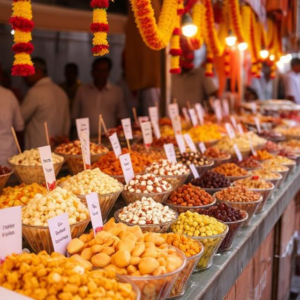
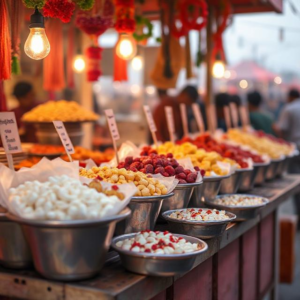
Bustling traditional Indian sweet stalls at the Maha Kumbh Mela
As the largest human gathering in the world, the Maha Kumbh Mela attracts millions of devotees and curious travelers to the holy city of Prayagraj. This sacred festival, held approximately every 12 years, becomes a culinary paradise, showcasing an array of traditional Indian recipes and street food that reflects India’s rich cultural heritage.
This comprehensive guide takes you on a gastronomic journey through the Maha Kumbh Mela, exploring its most iconic dishes. We’ll uncover the secrets behind their preparation and the stories that give these delicacies their deep cultural significance. You’ll also find step-by-step recipes to help you recreate these culinary masterpieces in your own kitchen.
The Culinary Significance of the Maha Kumbh Mela
The Maha Kumbh Mela isn’t just a spiritual gathering; it’s a vibrant spectacle of colors, sounds, and, most importantly, flavors. With stalls lining the streets, the festival offers a plethora of both sweets and savory dishes that tantalize the taste buds. Each dish tells a story rooted in tradition, history, and the spiritual significance of the festival.
Why Food Matters at the Maha Kumbh Mela
Food is at the heart of the Maha Kumbh Mela. It is a time for families to gather, share recipes, and indulge in dishes that may have been passed down through generations. The festival inherently fosters community, and food plays a significant part in that bond. Traditional sweets and snacks are not only delicious; they also embody the essence of Indian hospitality.
Iconic Dishes to Try at the Maha Kumbh Mela
Let’s dive into the heart of Indian cuisine celebrated at the Maha Kumbh Mela, featuring some must-try dishes that you can recreate in your kitchen!
1. Thandai
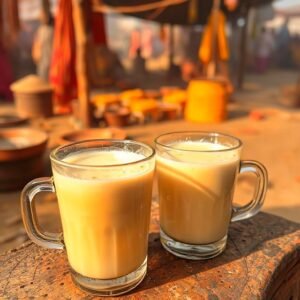
A quintessential drink of the Maha Kumbh Mela, Thandai is a creamy, sweet, and refreshing concoction enjoyed by many. Made predominantly from milk, sugar, cardamom, and saffron, this traditional Indian beverage is perfect for the hot atmosphere of the festival.
Thandai Recipe
Thandai is a popular Indian drink made with nuts, seeds, and spices. It’s a refreshing treat often enjoyed during festivals and celebrations. Here’s a simple recipe to make Thandai at home:
Ingredients:
– 1 cup warm water
– 3 tablespoons almonds (about 30 grams), rinsed
– 2 heaped tablespoons unsalted pistachios (about 20 grams), rinsed
– 2 tablespoons white poppy seeds (khus khus)
– ¼ cup melon seeds (about 30 grams)
– 2 tablespoons rose petals (dried or fresh) or use 2 tablespoons rose water or 2 tablespoons gulkand (rose preserve) instead
– 1 tablespoon fennel seeds
– ½ teaspoon whole black pepper
– 3 to 4 green cardamoms (remove the outer husks and keep the seeds)
– 15 to 18 strands of saffron (optional)
– ½ cup sugar (about 100 grams)
– 8 cups cold milk (add more if needed)
– Ice cubes (optional, as needed)
– A few rose petals or chopped almonds or pistachios for decoration
Instructions:
- Soak the Nuts and Seeds
In a bowl, pour in 1 cup of warm water. Add the almonds, pistachios, poppy seeds, melon seeds, dried rose petals, fennel seeds, and black pepper. Mix everything well. Cover the bowl and let it sit for at least 1 to 2 hours. If using room temperature water, you can let it soak overnight or for about 4 to 5 hours in the fridge.
- Prepare the Thandai Paste
After soaking for 1 to 2 hours, pour the entire mixture (including the soaking water) into a blender. Make sure to use a strong blender for this step. Add ½ cup of sugar, the seeds from 3 to 4 green cardamoms, and the saffron strands (if using). Blend until you have a smooth paste. Transfer it to a bowl and set aside. You can cover it and keep it in the fridge if you’re not using it right away.
- Make the Thandai Drink
To make the Thandai drink, take about 4 tablespoons of the Thandai paste in a glass. Feel free to use more or less paste based on your taste. Add chilled milk. You can also use a mix of milk and water if you prefer. Stir everything together well. Taste it and add more sugar if you like it sweeter. If you want it colder, add a few ice cubes. Garnish with rose petals or some chopped almonds or pistachios. Serve the Thandai right away. If you prefer, you can make a larger batch in a jug, chill it, then serve.
- Storage
If you want to prepare it ahead of time, store the Thandai paste in the fridge where it will stay good for about a week.
2. Jalebi
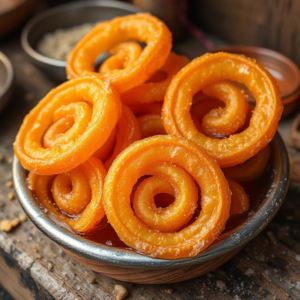
Jalebi is an iconic Indian dessert that captures the hearts and taste buds of many. These spiral-shaped treats are deep-fried and soaked in sugary syrup, often enjoyed warm or with rabdi, a rich milk-based dessert that balances the sweetness.
Jalebi Recipe
For Jalebi Batter:
– 1 cup all-purpose flour (about 125 grams)
– 2 tablespoons gram flour (besan)
– ⅛ teaspoon turmeric powder
– 1 pinch baking soda or ¼ teaspoon baking powder
– 1 cup water
– 1 to 2 tablespoons all-purpose flour (for later use)
For Sugar Syrup:
– 1 cup sugar (about 150 grams)
– ½ cup water
– ¼ teaspoon saffron strands
– Oil for deep frying (or ghee)
Instructions
- Make the Batter
In a bowl, mix the all-purpose flour, gram flour, turmeric powder, and baking soda (or baking powder). Stir well.
Next, add the water and mix until the batter is smooth. Break any lumps that form while mixing.
Then, stir the batter in a circular motion for 4 minutes to make it light and smooth. The batter should have a flowing consistency.
Cover the bowl and let the batter ferment in a warm place for 12 to 15 hours (or 6 to 10 hours in a hot climate).
After fermentation, the batter will have tiny air-pockets and a tangy taste. Stir the batter, and you’ll notice that it has become thinner. To thicken it, add 1 to 2 tablespoons of all-purpose flour and mix well.
Now, pour the batter into squeezy bottles (like tomato ketchup bottles) or use a piping bag.
- Prepare the Sugar Syrup
In a pan, combine the sugar and saffron strands. Add ½ cup of water and stir until the sugar dissolves.
Cook the sugar syrup on a low to medium heat until it reaches the one-string consistency.
Once it’s ready, switch off the heat and add a pinch of lime or lemon juice. Stir well and keep the syrup warm.
- Fry the Jalebi
Heat oil in a deep pan for frying. You can also use ghee or a mix of oil and ghee. When the oil is hot (350°F/176°C), squeeze the batter through the squeezy bottle or piping bag to create concentric rings.
Fry the jalebi until one side is partly cooked, then flip and fry the other side until it’s light golden.
Remove the jalebi from the oil and immediately dip them in the sugar syrup. Let them soak for 2 to 3 minutes, then remove with a wooden skewer or tongs.
Serve the jalebi hot, warm, or at room temperature. If you don’t plan to serve them right away, store them in an airtight container and refrigerate.
- Notes:
– Ensure the batter consistency is neither too runny nor too thick.
– Fermentation time may vary depending on your location’s temperature.
– Don’t over-fry the jalebi, as it will make them soft and fragile.
– The sugar syrup should have a one-string consistency to avoid absorbing too much syrup.
– Practice makes perfect while frying the jalebi, so don’t get discouraged if they don’t turn out perfectly the first time.
– You can halve or double this recipe as per your needs.
3. Kesar Puri Recipe
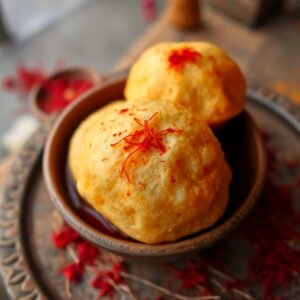
Another beloved dish at the Maha Kumbh Mela, Kesar Puri is a sweet and spicy fried bread that tantalizes the palate. Made with wheat flour and sweetened with sugar, these puris are often accompanied by a unique sweet and spicy sauce.
Kesar Puri Recipe
Ingredients:
– ½ cup semolina (sooji rava)
– ½ cup all-purpose flour (maida)
– 2 tablespoons plain yogurt
– 1 tablespoon hot ghee (for the dough)
– ¾ cup ghee (for frying)
– 1 cup sugar
– ½ cup water
– 1 tablespoon lemon juice
– 1 pinch saffron
Instructions:
- Make the Dough
In a mixing bowl, combine the semolina, all-purpose flour, yogurt, and hot ghee. Gradually add 1 to 2 tablespoons of warm water and knead the mixture to form a firm dough. Let the dough rest for 45 minutes.
- Beat the Dough
After resting, use a pestle (or a heavy object) to beat the dough for 5 minutes. This makes it softer and easier to roll out.
- Shape the Puri
Divide the dough into 15 equal balls. Roll each ball into a circle about 2 inches wide. Use a knife to make small holes in each rolled puri. This helps keep them from puffing up while frying and gives them a crispy and flaky texture.
- Prepare the Syrup
In a medium saucepan, combine the sugar and water. Cook over medium heat until it starts to boil gently. Add the lemon juice and saffron, then reduce the heat to low and let it simmer for 5 minutes. The syrup should look clear when it’s ready.
- Fry the Puri
In a small frying pan, heat the ghee over medium-low heat. Fry 3 to 4 puris at a time, cooking until they are lightly golden on both sides.
- Soak in Syrup
Once fried, take the puris out of the oil and dip them in the warm sugar syrup. Let them soak in the syrup while you fry the next batch of puris. After soaking, use tongs to remove the puris from the syrup.
- Serve and Store
Repeat the frying and soaking process until all the puris are done. You can store these sweet puris at room temperature for up to 3 days.
- Notes
– This recipe makes about 15 puris.
– Traditionally, puris are fried in ghee, but you can also use neutral oil if you prefer.
4. Malpua
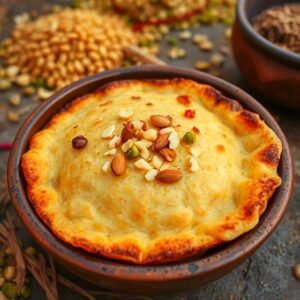
Malpua is a traditional Indian dessert resembling pancakes but sweetened with syrup. Typically served during festivals, these syrup-soaked delights have a rich history and are a must-try at the Maha Kumbh Mela.
Malpua Recipe
Ingredients:
For Malpua Batter:
– ¼ cup Mawa (Khoya)
– ½ cup All-Purpose Flour (Maida)
– 1 teaspoon Semolina (Sooji) – optional
– 1 pinch Salt
– 1 teaspoon Sugar
– ¾ cup + 2 tablespoons Milk
– ¼ teaspoon Crushed Fennel Seeds
– Ghee (for deep frying)
For Sugar Syrup:
– ½ cup Sugar
– ½ cup Water
– 4-5 strands Saffron
Instructions:
- Prepare the Mawa
If the mawa is in solid form, crumble or grate it to break it down.
- Make the Batter
In a bowl, combine the mawa and milk. Whisk them together until the mixture is almost smooth. Gradually add the all-purpose flour and semolina, plus the remaining milk. Mix well to create a smooth batter with no lumps. Whisk or beat the batter for about 5 minutes. A hand blender can also be used for this. Allow the batter to rest for at least 30 minutes or up to 2 hours.
- Finalize the Batter
After resting, add the salt, sugar, and crushed fennel seeds to the batter. Whisk again for 1-2 minutes. The consistency should be like buttermilk or condensed milk. Avoid a very thick batter, as it can make the malpuas heavy.
- Prepare the Sugar Syrup
In a saucepan, mix the sugar and water, and bring to a quick boil. Add the saffron strands and let it simmer for 2-3 minutes. The syrup should be thin, like the consistency of oil. To prevent it from crystallizing, add a few drops of lemon juice. If the syrup thickens, stir in a teaspoon or two of water to adjust the consistency.
- Fry the Malpua
In a thick-bottomed frying pan, heat about 1½ inches of ghee. Use a flat pan for the best results; avoid using a kadhai or wok. Before frying each malpua, give the batter a quick whisk. Pour about ⅛ cup (or 2 tablespoons) of the batter into the hot ghee without spreading it; it will naturally spread into a round shape. Lower the heat. After a minute, the malpua should start to float.
- Cook Until Golden
Fry the malpua on low heat. Once one side is light golden, gently flip it over and cook the other side until it is also light golden. Continue frying until both sides are golden, turning them as needed.
- Soak in Sugar Syrup
Immediately transfer the fried malpua to the sugar syrup and let them soak for 1-2 minutes. After soaking, take them out and place them on a serving tray. Continue this process for the rest of the batter.
- Serve
You can serve the malpuas on their own or with rabdi. Garnish with chopped almonds and pistachios for an extra touch!
Enjoy your delicious homemade malpuas!
5. Dahi Vada
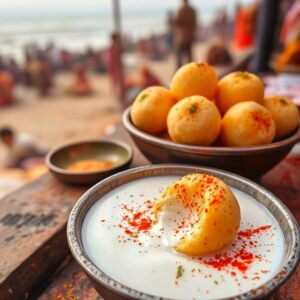
Dahi Vada is a popular yogurt-based snack that perfectly complements the spicy flavors of Indian cuisine. Made from lentils, this dish is both refreshing and nourishing, often served with raita, a yogurt-based condiment.
Dahi Vada Recipe
Ingredients:
For the Vada
– 1 cup Urad Daal (black gram lentils)
– ½ cup Water (for grinding the batter)
– 1 Green Chili
– 1 inch Ginger
– 1 teaspoon Kosher Salt
– 2 tablespoons Oil
For the Yogurt:
– 4 cups Plain Yogurt
– ½ cup Water
– ⅓ cup Sugar (adjust based on sweetness preference)
– 1 teaspoon Kosher Salt
For Garnish:
– ½ cup Tamarind Chutney
– 2 teaspoons Kashmiri Red Chili Powder
– 1 teaspoon Ground Cumin
– ¼ cup Thin Sev (optional)
– ¼ cup Fresh Cilantro, finely chopped (optional)
Instructions:
- Prepare the Urad Daal
Rinse the urad daal thoroughly under water 2 to 3 times. Soak the lentils in water for 5 to 6 hours, or overnight.
- Make the Vada Batter
After soaking, drain the water from the lentils. In a blender, combine the lentils, green chili, ginger, and just enough water to blend smoothly. The mixture should have a thick cake batter consistency. To check, drop a small amount into water; it should float.
- Aerate the Batter
Add the salt to the batter and use a hand mixer to beat it lightly. This helps incorporate air, making the vadas light and fluffy.
- Fry the Bhallas
Warm the oil in a deep frying pan over medium heat. Make sure the oil is not too hot or too cold. If it’s too hot, the bhallas will brown quickly but remain raw inside.
Once the oil is ready, drop spoonfuls of the batter into the hot oil and fry until the vadas are golden brown and crispy. Be careful not to overcrowd the pan. Leave enough space between each bhalla so they can fry evenly.
Remember, frying the bhallas requires patience and attention to ensure they are cooked perfectly.
Once cooked, remove the vadas from the pan and let them cool for about 10 minutes.
- Soak the Vadas
In a large bowl, add 4 cups of warm water. Gently place the vadas in the water and let them soak for 10 minutes.
- Prepare the Yogurt Mixture
In another bowl, whisk together the yogurt, water, salt, and sugar until smooth and pourable.
- Squeeze Excess Water
Take each vada from the water one at a time and gently squeeze out the excess water by pressing them between your palms. Arrange them in a large serving bowl.
- Repeat Cooking and Soaking
Repeat the cooking, soaking, and squeezing process for the remaining batter.
- Combine Vadas and Yogurt
Pour the prepared yogurt mixture over the vadas, gently stirring to ensure they are fully covered in yogurt.
- Chill Before Serving
Refrigerate the dish until you’re ready to serve. While you can serve it at room temperature, the vadas taste best when chilled. Aim to refrigerate for at least 2 to 3 hours.
- Serving the Dish
To serve, place 3-4 vadas with some yogurt on a plate. Add a tablespoon of tamarind-date chutney on top, then sprinkle with a pinch of red chili powder and ground cumin.
Finish by adding a spoonful of thin sev and garnishing with chopped cilantro, if desired. The cilantro and sev add great texture and flavor!
Enjoy your delicious vadas in yogurt!
The Cultural Significance of Each Dish
While each iconic dish brings its unique flavor and texture, they also have tales woven into the rich tapestry of Indian culture. The Maha Kumbh Mela represents more than just culinary delight; it embodies the spirit of community, faith, and shared heritage.
The Role of Street Food in Indian Culture
Street food in India, especially during festivals, serves as a means of connecting people. At the Maha Kumbh Mela, vendors set up stalls where families and friends gather, enjoying food that resonates with tradition. Every dish has a story—whether it’s the ancient origins of Jalebi or the regional variations of Dahi Vada—it helps preserve the culinary history of India.
How to Experience the Maha Kumbh Mela
For food enthusiasts aiming to explore the flavors of the Maha Kumbh Mela, visiting in person offers an extraordinary experience. The vibrant atmosphere filled with the aromas of spices, sweets, and fried delights is unmatched. Here are some tips for experiencing the festival fully:
- Visit the Right Time: The festival occurs over several weeks, so plan to visit during the key bathing dates to see the largest crowds.
- Explore Various Stalls: Don’t limit yourself to one or two dishes; sample a variety through small portions. This way, you can enjoy more flavors!
- Engage with Locals: Talk to the vendors and locals; they often share the rich history behind each dish and may offer tips for recreating them at home.
- Participate with Enthusiasm: Engage in the vibrancy of the festival. Whether it’s dancing, participating in rituals, or enjoying the food, immerse yourself in the experience fully.
Conclusion
The Maha Kumbh Mela is truly a culinary paradise, offering an extensive range of traditional Indian sweets and savory delicacies. From the refreshing Thandai to sweet Jalebi, crispy Kesar Puri, syrupy Malpua, and creamy Dahi Vada, these iconic dishes are a testament to India’s rich culinary heritage.
In this guide, we’ve explored the secrets behind these cherished recipes, providing you with step-by-step instructions to recreate these culinary masterpieces in your own kitchen. So, the next time you find yourself in Prayagraj during the Maha Kumbh Mela or simply looking to explore Indian cuisine, remember these delicious treats. Indulge in their flavors and take home the memories (and recipes) to last a lifetime.
Join the Culinary Journey!
Have you tried any of these dishes before? Share your experiences below or let us know your favorite Indian recipe! Happy cooking!
Maha Kumbh Mela Official Website: https://mahakumbh.in/
India Tourism Official Website: https://www.incredibleindia.gov.in/en
Indian Embassy Official Website: https://www.india.gov.in/topics/foreign-affairs/embassy-consulates

